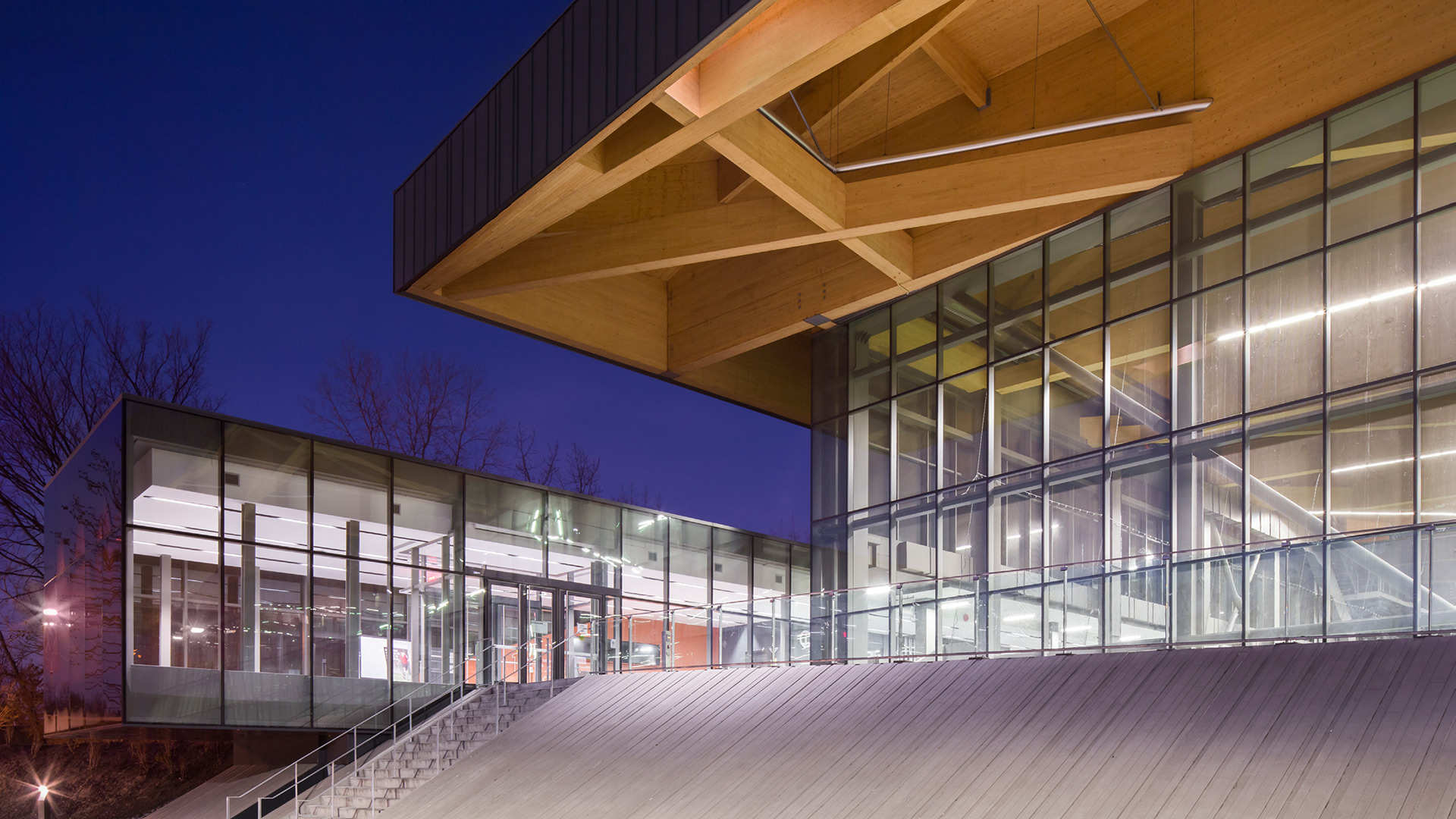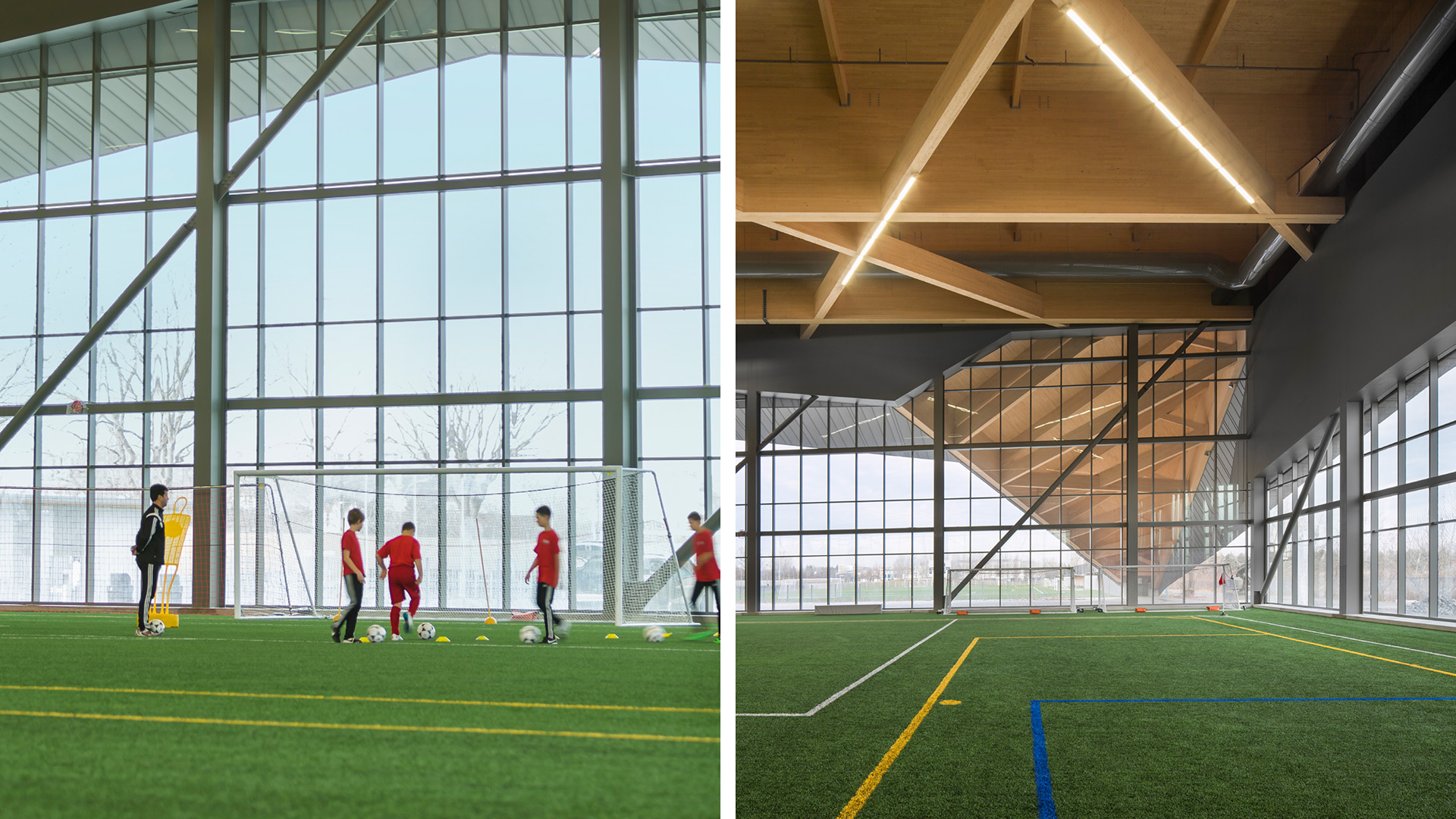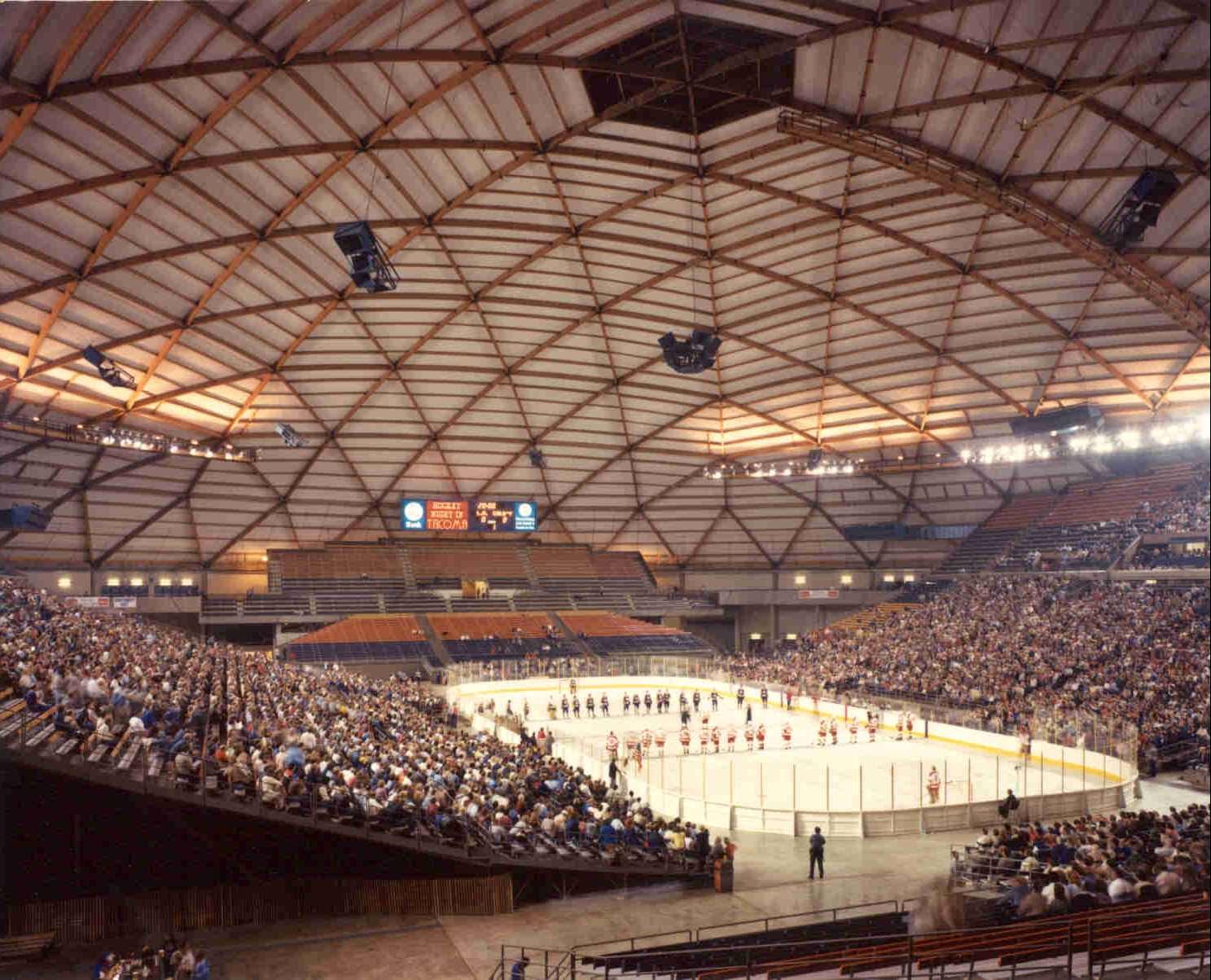“I wouldn’t take credit for paving the way, but we pushed the limits,” says Steve Turner, President of Western Wood Structures, who’s been working with large-scale wood structures since the mid 1970s. The Tualatin, Ore.-based firm has a long and storied history as the recordsetting design and fabrication company behind the world’s biggest timber arena domes. In fact, it holds the title for the three largest: Flagstaff, Ariz.’s Walkup Skydome, Tacoma, Wash.’s Tacoma Dome, and Northern Michigan University’s Superior Dome, in Marquette, Mich.
Turner and chief engineer Paul Gilham have seen an increase in the use of mass timber for arena structures. Thanks to new wood and connector systems technology, clear-span mass timber construction for sports and recreational facilities has become a competitive alternative to conventional concrete and steel techniques.
“Environmentalists are seeing wood as the more appropriate material because it’s a green resource,” says Gilham. “When you consider the amount of pollution it takes to build a wood structure versus steel or concrete, wood is way more advantageous in terms of being environmentally friendly.”
Turner says his company began to attract international interest for timber structures following the completion of the Tacoma Dome in 1987. Designed by local firm McGranahan Architects, the arena features an eye-popping 530-foot span. “We’ve grown by a factor of almost 20 in the last 25 years,” says Turner.
Western Wood Structures continues to take on major mass timber projects, and about 20% of its business involves the maintenance of large wood structures.
Mass timber 'brings ambience into the design'
Structural engineer Paul Fast, Founder of Vancouver-based design firm Fast + Epp, says increased interest in wood-constructed sports facilities is “absolutely” there, and his firm has several innovative large projects under way in the category.
A notable Fast + Epp project is the Richmond Olympic Oval, built for Vancouver’s 2010 Winter Games and now serves as a community sport facility.


Montreal’s Saint-Michel Environmental Complex Soccer Stadium’s mass timber structure is a one-of-a-kind, with its crisscrossed lattice design achieving an uninterrupted 225-foot span. Photos courtesy Nordic Structures | Photographer: © Stéphane Groleau
Another well-known project by Fast + Epp: Grandview Heights Aquatic Centre in Surrey, B.C., designed by HCMA Architecture + Design. It features the world’s longest timber catenary roof, built from spaghetti-like glulam cables. In the world of massive mass-timber, the drama, says Fast, is in the roof.
“With recreation facilities, there is more and more interest, primarily driven by the fact that wood brings ambience into the design,” says Fast, whose portfolio contains multiple examples of impressive mass timber roofed structures. “It just adds dimension of warmth and ambience into an arena or spectator experience that I think has been under-valued, under-estimated.”
Wood, says Fast, brings a warm, human element into the experience, “instead of having this faceless piece of structure floating above your head.”
This appeal of wood is showing up in an increasing number of North American stadiums showcasing long-spanning designs. Recent projects include a recently completed soccer stadium in Montreal designed by Saucier + Perrotte and HCMA; the TELUS Stadium for field sports at Laval University in Quebec City, designed by ABCP Architecture; and a 4,000-seat arena project designed by Opsis Architecture for the University of Idaho, that is set to use cross-laminated timber and expected to be completed in 2021.
Aesthetics aside, there’s always the bottom line, and Fast says engineers and designers of wood construction must show that wood is a competitive economic alternative to steel and concrete.
“You have to be very disciplined with your design approach otherwise the cost can run away,” says Jean-Marc Dubois, Director of Business Development with Nordic Structures. “If you are disciplined and sensible, you can make it work.”
Dubois says his company is stretched because of the demand. The firm is a major player in the arena market, including its roof work on the highly ambitious and technically complex Saint-Michel soccer stadium in Montreal—hailed as one of the most beautiful public buildings in Canada and a project that Dubois points out helped transform a former quarry into an sustainable eco-park.
“As the architect was standing across from the site, he looked at the gravel quarry there and started sketching what he was seeing with the quartz intrusions in strata. That became his inspiration for the roof, and to take that and turn it into wood was a stroke of genius,” says Dubois.
Dubois’s firm is looking at constructing outdoor arenas with mass timber roof shells that can be used in all seasons. He says that large mass timber structures such as arenas, which are often incredibly challenging feats of engineering and design, are guiding the wood residential and office tower industry—by contributing the technical know-how.

At 530 feet in diameter and 152 feet tall, the Tacoma Dome is one of the world’s largest wooden domed structures. Built more than 25 years ago, its longevity demonstrates the durability and resilience of longspan timber stadium construction and design. Photo courtesy Western Wood Structures, Inc.
“Building these large soccer stadiums and infrastructure projects allows us to prove out the engineering that is essential for taller wood rise buildings,” says Dubois. “Timber plays well with both, but it also encapsulates the carbon, and I think it’s an essential element for us to be able to mitigate climate change in the long haul.
“Hopefully, what we are doing now, by bringing these projects to the forefront, is engaging and stimulating people’s imaginations and telling them there is a future in timber,” says Dubois.
About the author
Kerry Gold has written about architecture, housing, city planning, and real estate for the Globe and Mail for the last 12 years. She has also served as a judge for the Architectural Institute of British Columbia and has written on land use and urban issues for various publications, including the Walrus, BC Business, Vancouver Magazine and South China Morning Post.
Related Stories
Mass Timber | Apr 25, 2024
Bjarke Ingels Group designs a mass timber cube structure for the University of Kansas
Bjarke Ingels Group (BIG) and executive architect BNIM have unveiled their design for a new mass timber cube structure called the Makers’ KUbe for the University of Kansas School of Architecture & Design. A six-story, 50,000-sf building for learning and collaboration, the light-filled KUbe will house studio and teaching space, 3D-printing and robotic labs, and a ground-level cafe, all organized around a central core.
ProConnect Events | Apr 23, 2024
5 more ProConnect events scheduled for 2024, including all-new 'AEC Giants'
SGC Horizon present 7 ProConnect events in 2024.
75 Top Building Products | Apr 22, 2024
Enter today! BD+C's 75 Top Building Products for 2024
BD+C editors are now accepting submissions for the annual 75 Top Building Products awards. The winners will be featured in the November/December 2024 issue of Building Design+Construction.
Mass Timber | Apr 22, 2024
British Columbia changing building code to allow mass timber structures of up to 18 stories
The Canadian Province of British Columbia is updating its building code to expand the use of mass timber in building construction. The code will allow for encapsulated mass-timber construction (EMTC) buildings as tall as 18 stories for residential and office buildings, an increase from the previous 12-story limit.
Mass Timber | Feb 15, 2024
5 things developers should know about mass timber
Gensler's Erik Barth, architect and regional design resilience leader, shares considerations for developers when looking at mass timber solutions.
Sponsored | Performing Arts Centers | Jan 17, 2024
Performance-based facilities for performing arts boost the bottom line
A look at design trends for “budget-wise” performing arts facilities reveals ways in which well-planned and well-built facilities help performers and audiences get the most out of the arts. This continuing education course is worth 1.0 AIA learning unit.
75 Top Building Products | Dec 13, 2023
75 top building products for 2023
From a bladeless rooftop wind energy system, to a troffer light fixture with built-in continuous visible light disinfection, innovation is plentiful in Building Design+Construction's annual 75 Top Products report.
Products and Materials | Oct 31, 2023
Top building products for October 2023
BD+C Editors break down 15 of the top building products this month, from structural round timber to air handling units.
Biophilic Design | Oct 29, 2023
Natural wood floors create biophilic experience in Austrian headquarters office
100% environmentally friendly natural wood floors from mafi add to the biophilic setting of a beverage company office in Upper Austria.
Mass Timber | Oct 27, 2023
Five winners selected for $2 million Mass Timber Competition
Five winners were selected to share a $2 million prize in the 2023 Mass Timber Competition: Building to Net-Zero Carbon. The competition was co-sponsored by the Softwood Lumber Board and USDA Forest Service (USDA) with the intent “to demonstrate mass timber’s applications in architectural design and highlight its significant role in reducing the carbon footprint of the built environment.”

















